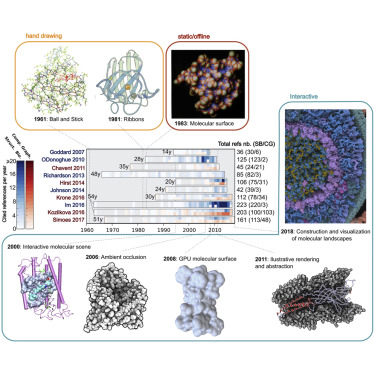Our official English website, www.x-mol.net, welcomes your
feedback! (Note: you will need to create a separate account there.)
Molecular Graphics: Bridging Structural Biologists and Computer Scientists.
Structure ( IF 4.4 ) Pub Date : 2019-09-26 , DOI: 10.1016/j.str.2019.09.001 Xavier Martinez 1 , Michael Krone 2 , Naif Alharbi 3 , Alexander S Rose 4 , Robert S Laramee 3 , Sean O'Donoghue 5 , Marc Baaden 1 , Matthieu Chavent 6
Structure ( IF 4.4 ) Pub Date : 2019-09-26 , DOI: 10.1016/j.str.2019.09.001 Xavier Martinez 1 , Michael Krone 2 , Naif Alharbi 3 , Alexander S Rose 4 , Robert S Laramee 3 , Sean O'Donoghue 5 , Marc Baaden 1 , Matthieu Chavent 6
Affiliation

|
Visualization of molecular structures is one of the most common tasks carried out by structural biologists, typically using software, such as Chimera, COOT, PyMOL, or VMD. In this Perspective article, we outline how past developments in computer graphics and data visualization have expanded the understanding of biomolecular function, and we summarize recent advances that promise to further transform structural biology. We also highlight how progress in molecular graphics has been impeded by communication barriers between two communities: the computer scientists driving these advances, and the structural and computational biologists who stand to benefit. By pointing to canonical papers and explaining technical progress underlying new graphical developments in simple terms, we aim to improve communication between these communities; this, in turn, would help shape future developments in molecular graphics.
中文翻译:

分子图形学:架桥结构生物学家和计算机科学家。
分子结构的可视化是结构生物学家通常使用诸如Chimera,COOT,PyMOL或VMD之类的软件执行的最常见任务之一。在这篇“观点”文章中,我们概述了计算机图形学和数据可视化的过去发展如何扩展了对生物分子功能的理解,并总结了有望进一步转变结构生物学的最新进展。我们还将重点介绍两个社区之间的沟通障碍如何阻碍分子图形学的进展:推动这些进步的计算机科学家以及受益的结构和计算生物学家。通过简单地引用规范性论文并解释新图形开发背后的技术进步,我们旨在改善这些社区之间的交流;反过来,
更新日期:2019-09-26
中文翻译:

分子图形学:架桥结构生物学家和计算机科学家。
分子结构的可视化是结构生物学家通常使用诸如Chimera,COOT,PyMOL或VMD之类的软件执行的最常见任务之一。在这篇“观点”文章中,我们概述了计算机图形学和数据可视化的过去发展如何扩展了对生物分子功能的理解,并总结了有望进一步转变结构生物学的最新进展。我们还将重点介绍两个社区之间的沟通障碍如何阻碍分子图形学的进展:推动这些进步的计算机科学家以及受益的结构和计算生物学家。通过简单地引用规范性论文并解释新图形开发背后的技术进步,我们旨在改善这些社区之间的交流;反过来,











































 京公网安备 11010802027423号
京公网安备 11010802027423号